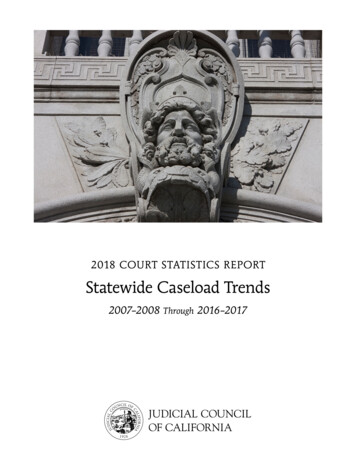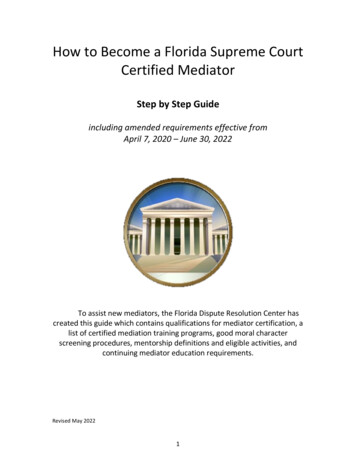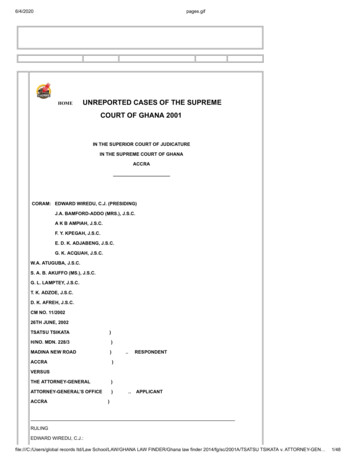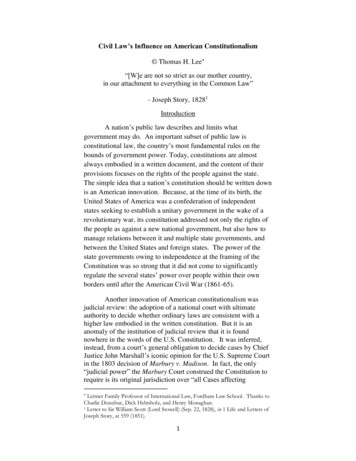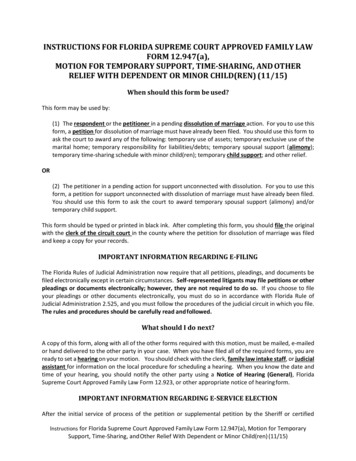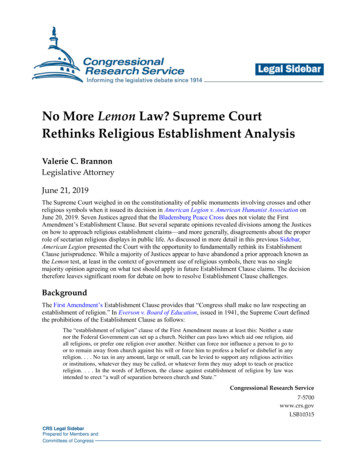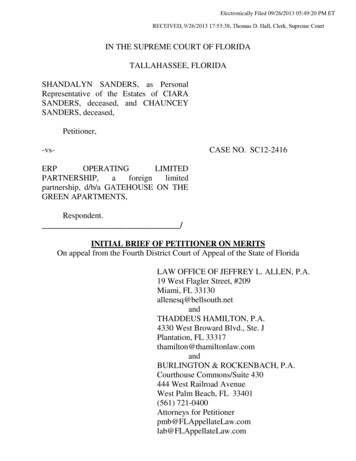
Transcription
Electronically Filed 09/26/2013 05:49:20 PM ETRECEIVED, 9/26/2013 17:53:38, Thomas D. Hall, Clerk, Supreme CourtIN THE SUPREME COURT OF FLORIDATALLAHASSEE, FLORIDASHANDALYN SANDERS, as PersonalRepresentative of the Estates of CIARASANDERS, deceased, and CHAUNCEYSANDERS, deceased,Petitioner,-vs-CASE NO. mitedpartnership, d/b/a GATEHOUSE ON THEGREEN APARTMENTS,Respondent./INITIAL BRIEF OF PETITIONER ON MERITSOn appeal from the Fourth District Court of Appeal of the State of FloridaLAW OFFICE OF JEFFREY L. ALLEN, P.A.19 West Flagler Street, #209Miami, FL 33130allenesq@bellsouth.netandTHADDEUS HAMILTON, P.A.4330 West Broward Blvd., Ste. JPlantation, FL 33317thamilton@thamiltonlaw.comandBURLINGTON & ROCKENBACH, P.A.Courthouse Commons/Suite 430444 West Railroad AvenueWest Palm Beach, FL 33401(561) 721-0400Attorneys for .com
TABLE OF CONTENTSPAGETABLE OF AUTHORITIESiii-ivPREFACEvSTATEMENT OF THE FACTS1-8STATEMENT OF THE CASE9-14SUMMARY OF ARGUMENT15-16ARGUMENT16-29THE FOURTH DISTRICT ERRED IN CONCLUDING,AS A MATTER OF LAW, THAT THE PLAINTIFFCOULD NOT PROVE PROXIMATE CAUSE, ANDTHAT AS A RESULT, THE DEFENDANT WASENTITLED TO A DIRECTED VERDICT ONLIABILITY.CONCLUSION30CERTIFICATE OF SERVICE31CERTIFICATE OF TYPE SIZE & STYLE32ii
TABLE OF AUTHORITIESPAGECasesBrown v. Motel 6 Operating, L.P.,989 So.2d 658 (Fla. 4th DCA 2008)26, 27Brown v. Motel 6 Operating, L.P., Ltd.,1 So.3d 171 (Fla. 2009)27Burkhart v. Ward,861 P.2d 317 (Okla. App. 1991)24Cox v. St. Joseph’s Hospital,71 So.3d 795 (Fla. 2011)17, 19Dep’t of Transportation v. Anglin,502 So.2d 896 (Fla. 1987)18Etheredge v. Walt Disney World Co.,999 So.2d 669 (Fla. 5th DCA 2009)18Fund v. Hotel Lenox of Boston, Inc.,635 N.E.2d 1189 (Mass. 1994)27Green Companies v. Divincenzo,432 So.2d 86 (Fla. 3d DCA 1983)23Helman v. Seaport Coastline Railroad Co.,349 So.2d 1187 (Fla. 1977)18Holley v. Mt. Zion Terrace Apartments, Inc.,382 So.2d 98 (Fla. 3d DCA 1980)19, 20, 21, 22Jenness v. Sheraton Cadillac Properties, Inc.,211 N.W. 2d 106 (Mich. App. 1973)24Lindsey v. Bell South Telecommunications, Inc.,943 So.2d 963 (Fla. 4th DCA 2006)18iii
McCain v. Fla. Power Corp.,593 So.2d 500 (Fla. 1992)17, 26North v. Mayo Group Development, L.L.C.,2013 WL 2319430 (M.D. Fla. 2013)21, 22Nunez v. Lee County,777 So.2d 1016 (Fla. 2d DCA 2000)18Olson v. Crowell Plumbing & Heating Co., Inc.,48 So.3d 139 (Fla. 5th DCA 2010)18Pamperin v. Interlake Cos., Inc.,634 So.2d 1137 (Fla. 1st DCA 1994)18Regency Lake Apartments Associates Limited v. French,590 So.2d 970 (Fla. 1st DCA 1991)18Sawyer v. Allied International Holdings, Inc.,707 So.2d 761 (Fla. 2d DCA 1998)18Stahl v. Metropolitan Dade County,438 So.2d 14 (Fla. 3d DCA 1983)19Statutes§83.47(1)(b), Fla. Stat.2Other AuthoritiesFla. St. Jury Instr. 401.1219iv
PREFACEThis is Petitioner's request for discretionary review of a decision of theFourth District Court of Appeal dated July 18, 2012.Petitioner, SHANDALYN SANDERS, will be referred to as “Petitioner” or“Sanders.” Respondent, ERP OPERATING LIMITED PARTNERSHIP, a foreignlimited partnership, d/b/a GATEHOUSE ON THE GREEN APARTMENTS, willbe referred to as “Respondent” or “Gatehouse” respectively.The following designations will be used:(R) - Record-on-Appeal(T) - Trial Transcript(A) - Appendix to Jurisdictional Brief(AA) – Appendix to Answer Briefv
STATEMENT OF THE FACTSDefendant, ERP Operating Limited Partnership (hereafter “ERP”), a foreignlimited partnership, d/b/a Gatehouse on the Green, marketed Gatehouse on theGreen as “resort living at its very best” and as a “gated community” (Pl’s Ex. 2,AA11). That apartment complex is located in Plantation, Florida, which wasunanimously described by witnesses as appearing to be a “very safe” city (T263,977). There are 312 apartments at Gatehouse on the Green, 12 buildings and over1,000 residents (T365). On November 29, 2004, Ciara Sanders (“Ciara”), 19 yearsold, filled out an application for rental of a two bedroom, two bath apartment (Def.Ex.6, AA107-09). She provided information as to her prior residences, past andcurrent employment, and her credit history (Ibid).Ciara was taking collegecourses in addition to working, and was studying to be an architect (T1160-61).The third page of the application form contained a checklist to be filled outby the owner’s agent, showing that, inter alia, a credit check of the applicant hadbeen completed, the credit report was attached, and the applicant’s employmentand residential history had been verified (Def. Ex. 6, AA107-09).Ciara’sapplication form showed that the checklist was filled out by Defendant’s agent onNovember 30, 2004 (Def. Ex. 6, AA109).On December 1, 2004, Ciara signed a lease for a two bedroom, two bathapartment, and in addition to the monthly rent, she paid additional charges1
including a 20 gate card fee and a 10 gate card deposit (Def. Ex. 8, AA111).Those fees were charged to provide the gate card for limited access through theentrance gate (T317). Ciara and her brother Chauncey moved into the apartmentand Ciara’s boyfriend Evan Mesadieu lived there as well (T820).Defendant apparently did not believe it owed any duty to tenants to exerciseany degree of care regarding security, as it so stated in the lease, which alsorequired tenants to exonerate the lessor for any failure to provide such security(Def. Ex. 8, AA115):19. Security: Resident acknowledges and agrees that protectionagainst criminal action is not within Lessor’s power, that Lessor doesnot provide (and does not have a duty to provide) any securityprotection services, security lighting or any other security measures atthe Community, that Lessor has no obligation to conduct criminalbackground checks on actual or potential residents or occupants, thatResident shall look solely to the public police for security protectionand Resident and Occupant are responsible for their personal security.Lessor shall not be liable for failure to provide such securitymeasures, for failure to conduct such criminal background checks orfor criminal or wrongful actions by others against Resident, Occupant,Guests or others, including actions by others which cause damage tothe property of Resident, Occupant or Guests.That provision violated §83.47(1)(b), Fla. Stat., and was therefore void andunenforceable; and the jury was so instructed (T1431).Courtesy OfficerThe operating guidelines for Gatehouse on the Green provided for a courtesyofficer to live on the premises and, at the time of the incident, a Plantation police2
officer received reduced rent in return for agreeing to perform that function (T398).Defendant marketed the property as having a courtesy officer, and while theoperating guidelines required that the security officer patrol the premises twice aday, it was undisputed that he was not there on the night of the decedents’ deaths(T319, 362-63). Additionally, the courtesy officer was required to fill out dailyincident reports; however, no such reports were ever produced in this case, andDefendant’s representatives admitted there were no such written reports (T399,411-12, 752).Defendant’s representative admitted that part of the courtesyofficer’s duties was to maintain a presence on the property (T725). However,Michael Rathburn (“Rathburn”), who resided at Gatehouse on the Green from2004 through 2006, testified that he never saw the courtesy officer the entire timehe lived there (T512-13).Notices of CrimeGatehouse on the Green was owned by Defendant, ERP, a national companythat owns approximately 100 properties in the eastern United States, and has apolicies and procedures manual that requires, inter alia, notices to residents ofcriminal activities on the premises (Pl’s Ex. 1, AA2-9, T565, 1110). That writtenpolicy states that a notice to residents is recommended when “a significant crime”occurs on the property, especially a violent crime or a forced entry burglary (Pl’s3
Ex. 1, AA2). However, the policy provided that whether a notice should beprovided to residents, and the content of any such notice, “had to be discussed inadvance with ERP’s legal representative” (Pl’s Ex. 1, AA2). While Defendant’spolicy was for the notices to be delivered to residents on the same day thatmanagement learned of the criminal incident, the manual also stated (in capitalletters) that all such notices had to be faxed to Defendant’s legal representative forreview and approval before being distributed to residents (Pl’s Ex. 1, AA2). It isundisputed that the “legal representative” of Defendant was a paralegal in Chicago(T313).Despite Defendant’s policies and procedure manual, Colleen Yeager(“Yeager”), the regional manager for ERP, conceded that she was not aware therewas a written policy to notify tenants of crimes occurring on the property (T310).After being shown the manual, she conceded there was such a requirement (T31112). However, despite the fact that there was documentation of twenty criminalincidents on the Gatehouse on the Green premises in the three years prior to thedecedents’ deaths, Yeager admitted that no notices had ever been provided totenants regarding criminal activity on the premises during that time period (T312).Kirin Bozan Jackson (“Jackson”), the property manager for Gatehouse onthe Green, testified that she assumed tenants would inform management of anycriminal activity, despite the terms of the lease which directed tenants to report4
crime only to the police (T429). While she was aware that any notice of criminalactivity required that she call Chicago to have Defendant’s “legal representative”approve the notice, Jackson was unable to testify to a single time she had evercontacted Chicago regarding whether a notice of criminal activity should beprovided to tenants (T433-45).In addition to recommending that the residents be notified of criminalactivities on the premises, the ERP policy manual also provided a specific form fornotices of violent crimes, as well as disturbances such as domestic disputes, etc.(Pl’s Ex. 1, AA2-9).Nonetheless, despite the fact that the twenty criminalincidents included 7 burglaries of apartments, 2 robberies, and 11 motor vehiclethefts, no notice was ever provided to any tenants (T307).Additionally, ERP’s policy manuals required incident reports to be preparedand provided to its risk management department if there was damage to ERP’sproperty, injury to any individual, theft, damage or loss of a resident’s belongings,or any criminal incident (T356).Nonetheless, despite the twenty criminalincidents identified through documentation, no such incident reports were everprepared at Gatehouse on the Green (T300, 357-62).5
Entrance GateGatehouse on the Green was marketed as a “gated community.”1 The gate was asignificant security precaution because the Gatehouse on the Green premises hadwater surrounding 70% of its perimeter, and a wall or fence on the remainingboundaries (T1000). There was documentation of at least two criminal incidentsoccurring in the prior three years while the gate had been broken, in which thecriminals had followed tenants into the property; one case resulting in an armedrobbery and the other in a burglary (T350-53).There was extensive evidence at trial that the gate was broken and left in theopen position repeatedly in the years prior to the murders of the decedents (T848,874). Michael Rathburn, who lived at Gatehouse on the Green for two years,testified that he complained multiple times about the gate being broken (T509-10).At trial, Plaintiff demonstrated that the gate had remained broken for at least twomonths immediately prior to the decedents’ deaths on September 7, 2005 (T457).A vendor had submitted a proposal to fix the gate on July 6, 2005, but a contract todo the work was not entered into until August 5, 2005, (T459-60). That contractprovided for a starting date of August 15, 2005 and a finishing date of October 15,2005 (T459-60), but nothing had been done prior to the decedents’ deaths.1The lease provided that the automated entrance gate could be removed at anytime and that it was only for “lessor’s own purposes,” whatever that means (Pl’sEx. 2, AA11; Def’s Ex. 8, AA115).6
It was undisputed that on the night of the incident the gate was broken andleft in the open position (T316, 454). Jackson acknowledged that it had beenbroken for a while and claimed that the vendor which contracted to replace it statedthat it was so old that replacement parts were no longer available (T459-60).Defendant’s contention that it had acted reasonably and expeditiously to get thegate fixed prior to the murders was belied by the fact that the day after the incidentthe gate was fixed (T480).The IncidentOn the evening of September 7, 2005, Ciara and Chauncey were murdered atGatehouse on the Green (T1117). Both were shot in their apartment, with Ciarabeing shot six times, including in her lower extremities, hand, neck and head(Ibid). Chauncey was shot execution style in the back of the head (T909). Despitebeing shot six times, Ciara did not die in the apartment, but died later at thehospital (T1142). Ciara was found alive at the apartment with her three month oldbaby next to her unharmed (T1140).Based on shell casings found on the floor at the scene, it was clear that atleast one semi-automatic pistol was used by the perpetrators (T889). There was noindication of forced entry; however, an engagement ring valued at 1,000, over 1,140 in cash, some credit cards, and a computer modem were stolen from the7
apartment (T928-1121). The police were at the scene the evening of the crime and,although they commenced an investigation, no perpetrators have been apprehended(T612, 825).While Gatehouse on the Green had never previously provided notices ofprior criminal activity, it did circulate a notice regarding this crime the day after itoccurred (Def’s Ex. 7, AA110, T673). That notice informed tenants that Ciara andChauncey knew their attackers, a fact that has never been established; and it wasadmitted into evidence over Plaintiff’s objection at trial (T673), and is the subjectof Plaintiff’s cross-appeal.8
STATEMENT OF THE CASEShandalyn Sanders, as Personal Representative of the Estates of CiaraSanders and Chauncey Sanders, filed a Complaint alleging negligence claimsagainst Defendant, ERP Operating Limited Partnership, d/b/a Gatehouse on theGreen Apartments (R-1-1-8). Defendant filed an Answer denying virtually everyallegation of the Complaint (R-1-9-10).Expert TestimonyAt trial, Plaintiff presented the testimony of Dr. George Kirkham, who has aPh.D. in criminology from the University of California at Berkeley (T521). Hetestified that most of the crimes at Gatehouse on the Green in the three years priorto the murders were opportunistic crimes (T540-49, 585).Those are crimescommitted by perpetrators who look for easy or “soft” targets, and cruise an areanot sure if they are going to break into a car, steal a purse, etc. (T540-44, 585). Dr.Kirkham testified that such precursor crimes need to be monitored and publicizedby the landowner, because the residents’ awareness is the “cornerstone of crimeprevention” (T541-42). In fact, he noted that Defendant’s training video informedits personnel that they needed to minimize such problems “through awareness”(T563). He testified that Defendant did not act reasonably or consistent with its9
own training video, because it was not even aware of the crimes occurring on theirproperty, nor informing residents of them (T565).Dr. Kirkham testified that opportunistic criminals need to be precluded fromeasy access to the premises, such as by a gated community, which Defendant’sapartment complex was supposed to be (T544). He noted Defendant’s trainingvideo stated that it was of “utmost importance” that mechanical failures such as theentry gate be repaired as soon as reasonably possible (T572).However, theevidence demonstrated that the gate was inoperable for four months during theyear of these murders (T573).Dr. Kirkham also testified that to deter opportunistic crimes, the residentsneed to be aware of criminal incidents and suspicious activity (T555-56). By beingmade aware of that information which relates to their personal safety and theprotection of their property, residents can protect themselves by increasing theirvigilance (T555-57).Dr. Kirkham testified that ERP did nothing to learn of criminal activity onits premises, even though the local Police Department would provide thatinformation for free (T558). ERP did not follow the reasonable steps in its ownpolicy manual regarding notifying residents of criminal activity (T564-66).Dr. Kirkham reviewed the reports of the twenty criminal incidents reportedat Gatehouse on the Green in the preceding three years, and noted that they were10
opportunistic crimes that were “highly deterrable through conventional targethardening measures” (T585). Those measures included limiting access by havingan operable traffic gate and increasing residents’ awareness and vigilance (T58586).Dr. Kirkham was also asked how he would classify the murders of thedecedents. He testified that based on the evidence it appeared that it was anopportunistic crime that escalated, and that it was not a targeted hit, as Defendant’sexpert opined (T592-94). The Defendant’s expert opined that the murders wereplanned by an “assassin” and that there was nothing the Defendant could havedone to prevent them (T1030). Dr. Kirkham noted that a targeted hit would bedone professionally with a minimum of risks, and these murders were sloppy andrecklessly committed (T592).He testified that Ciara’s apartment was a badlocation for a “hit” since it was at the very back of the Gatehouse on the Greenproperty which had 300 units, which meant there was no easy exit (T592). Therewere multiple gunshots with many shell casings left at the scene (T593). Dr.Kirkham testified that the number of bullets used to kill Ciara was indicative ofpanic and overkill, not the conduct of a planned and targeted hit (T595). He alsonoted that cash, a credit card, jewelry and a computer were removed from theapartment, and that a professional killer would not waste time rummaging aroundlooking for such items after a targeted hit (T595). Based on this evidence, Dr.11
Kirkham testified that it appeared the killing occurred in the course of anotherfelony, such as a home invasion and, thus, was an opportunistic crime (T594).Without objection, Dr. Kirkham testified to issues of causation. He testifiedthat this incident was foreseeable in light of the prior criminal history on thepremises, and that Defendant’s omissions contributed to the likelihood of such acrime, including permitting the gate to be broken for long periods of time, and notinforming residents of the extent of known criminal conduct on the premises(T605).Dr. Kirkham testified that the criminal incidents such as those whichcaused the decedents’ deaths are “highly deterrable through conventional targethardening measures” (T585).Defendant’s security expert was William Booth, who did not have a degreein criminology (T1025). He had previously filed an affidavit in the case in whichhe opined that Ciara had been murdered by a “professional assassin” (R-15-2407;T1060). While his affidavit stated that nothing was missing from the apartmentafter the murders, in his deposition he testified that he believed that certain itemshad been stolen (T1138). Booth acknowledged that Ciara had been shot six times,including in the lower extremities, neck and head; and he stated it was “difficult toenvision” that they were defensive wounds, and suggested that the number of shotsmight indicate that the killer was “sending a message” (T1142).12
Defendant relied on Booth’s testimony to argue to the jury that the decedentsknew their attacker(s) and alternatively that the decedents were comparativelynegligent for opening the apartment door to the “assassin” (T1020, 1041).Verdict and JudgmentThe jury returned a verdict finding that Defendant and each of the decedentshad been negligent and apportioning fault 40% to Defendant and 60% to thedecedents on each claim (R-21-3573-77). The jury awarded total damages (beforethe comparative negligence reduction) of 3.75 million to the three survivors ofCiara Sanders’ estate and 750,000 to the two survivors of Chauncey Sanders’estate (R-21-3573-77). After denying Defendant’s post-trial motions, the Courtentered Judgment consistent with the jury verdict (R-22-3775-79).Defendant appealed the Judgments to the Fourth District Court of Appeal,which issued an Opinion reversing and remanding the case for entry of judgment infavor of the Defendant.While the Fourth District recognized that there wasevidence sufficient to support a finding that Defendant had breached its duty toprovide adequate security, the Court ruled that Plaintiff could not establish that thebreach was the proximate cause of the murders because there was no evidence offorced entry into their apartment.The Fourth District’s Opinion contains aninaccuracy when it states that: “Of the twenty crimes which occurred in the13
premises in the three years leading up to the murders, none were violent crimes norpredicted homicide.” In fact, there were three incidents involving violence or thethreat of violence. On January 27, 2003, there was a burglary of an apartment inwhich the victim was confronted, grabbed by her hair and dragged into herapartment and slapped (T931-32). On March 8, 2004, there was a robbery of apizza delivery person in which three males confronted him, pushed him to theground and stole his merchandise and cash (T991-92). On August 28, 2004, therewas an armed robbery in which the perpetrator followed the victim into thecomplex (apparently through the broken gate) and after she parked came up behindher with a gun and told her to give him everything she had or he would kill her(T935-36). Thus, three of the incidents involved either violence or threat ofviolence (with a firearm).Plaintiff filed a Motion for Rehearing which was denied and, thereafter, shesought review in this Court. This Court provisionally accepted jurisdiction anddirected the parties to file briefs on the merits.14
SUMMARY OF ARGUMENTThe Fourth District erred in ruling that the Plaintiff failed, as a matter of law,to present evidence sufficient to create a factual issue regarding causation in thisnegligent security case.This Court has repeatedly held that the question ofproximate cause is classically a jury issue, which can only be determined as amatter of law if the evidence is unequivocal and leads to only one reasonableconclusion. Here, as the Fourth District acknowledged, the Plaintiff presentedsufficient evidence that the Defendant landlord had breached its duty to providereasonable security measures for the residents of Gatehouse on the Green. TheFourth District seized on one fact, that there was no evidence of forcible entry, tojustify a conclusion that as a matter of law, the Defendant’s negligence could nothave been causally related to the decedents’ deaths. However, common sense andthe testimony of Plaintiff’s expert, compel the conclusion that the Defendant’sfailure to maintain the security gate and ensure that the courtesy officer performedhis function could reasonably be found to be causally related to the crimes that leadto the decedent’s deaths. Additionally, it is undisputed that despite having twentyreported criminal acts on the premises in the prior three years, the Defendantviolated its own policies by failing to provide any notice to the residents of thatdanger. As Plaintiff’s expert testified, awareness of the criminal activity on thepremises was necessary to properly inform the residents and enable them to15
exercise vigilance on their own behalf to deter such misconduct. With this factualpredicate, the issue of proximate cause was clearly a question of fact which did notlead to only one reasonable conclusion, and, therefore, it should have been aquestion of fact for the jury, as the trial court ruled. For these reasons, this Courtshould quash the decision of the Fourth District and remand the case for entry ofjudgment in accordance with the jury verdict.ARGUMENTTHE FOURTH DISTRICT ERRED IN CONCLUDING, AS AMATTER OF LAW, THAT THE PLAINTIFF COULD NOTPROVE PROXIMATE CAUSE, AND THAT AS A RESULT, THEDEFENDANT WAS ENTITLED TO A DIRECTED VERDICT ONLIABILITY.The Fourth District reversed the trial court’s denial of Defendant’s Motionfor Directed Verdict on the issue of causation and remanded the case to the trialcourt for entry of judgment in favor of the Defendant. The Fourth District heldthat since there was no evidence of forcible entry into the decedents’ apartment,the Plaintiff was unable, as a matter of law, to prove that the Defendant’snegligence was a proximate cause of the decedents’ deaths. That ruling is contraryto decisions of this Court and other district courts regarding the application of thedirected verdict standard to causation issues.It is also inconsistent with theprinciple that in negligence cases proximate cause is ordinarily a question of fact to16
be determined by the jury based on all the facts and circumstances. In McCain v.Fla. Power Corp., 593 So.2d 500, 504 (Fla. 1992), this Court has stated:The judge is free to take this matter [causation] from the fact-finderonly where the facts are unequivocal, such as where the evidencesupports no more than a single reasonable inference.Here, the evidence does not unequivocally support a finding that Defendant’snegligence had no causal connection to the decedents’ deaths and, therefore, theFourth District erred in ruling that a directed verdict should have been granted.In this case, the Fourth District specifically acknowledged that Plaintiffpresented sufficient evidence to prove that Defendant had breached its duty toprovide adequate security to residents of Gatehouse on the Green. Nonetheless, itdetermined that a directed verdict was justified solely because there was noevidence of forcible entry into the decedents’ apartment. However, as discussed inmore detail below, that fact alone does not logically compel the conclusion thatDefendant’s negligence had no causal connection to the decedents’ deaths.Recently, in Cox v. St. Joseph’s Hospital, 71 So.3d 795, 801 (Fla. 2011),this Court reversed a district court for holding that a directed verdict should havebeen granted on causation in a negligence case, stating:As our review of the case law illuminates, while a directed verdict isappropriate in cases where the plaintiff has failed to provide evidencethat the negligent act more likely than not caused the injury, it is notappropriate in cases where there is conflicting evidence as to thecausation or the likelihood of causation. If the plaintiff has presented17
evidence that could support a finding that the defendant more likelythan not caused the injury, a directed verdict is improper.Additionally, district courts in Florida have repeatedly held that directedverdict motions should be treated with special caution in negligence cases becausethe evidence supporting the elements of such claims are frequently subject to morethan one interpretation. See Etheredge v. Walt Disney World Co., 999 So.2d 669,671 (Fla. 5th DCA 2009); Nunez v. Lee County, 777 So.2d 1016 (Fla. 2d DCA2000); Regency Lake Apartments Associates Limited v. French, 590 So.2d 970,972 (Fla. 1st DCA 1991).Moreover, this Court has long held that the question of whether adefendant’s negligence was a proximate cause of plaintiff’s injuries is generallyone for the jury, Helman v. Seaport Coastline Railroad Co., 349 So.2d 1187, 1189(Fla. 1977); Dep’t of Transportation v. Anglin, 502 So.2d 896, 899 (Fla. 1987).The district courts are clearly in accord, e.g., Pamperin v. Interlake Cos., Inc., 634So.2d 1137, 1139 (Fla. 1st DCA 1994) (“The circumstances under which a courtmay resolve the question of proximate cause as a matter law are extremelylimited.”); Lindsey v. Bell South Telecommunications, Inc., 943 So.2d 963, 966(Fla. 4th DCA 2006) (same); Olson v. Crowell Plumbing & Heating Co., Inc., 48So.3d 139, 143 (Fla. 5th DCA 2010) (same); Sawyer v. Allied InternationalHoldings, Inc., 707 So.2d 761, 763 (Fla. 2d DCA 1998) (“proximate cause18
questions generally must be resolved by the trier of fact based on all the facts andcircumstances presented”).Of course, there can be more than one cause of a plaintiff’s injuries or death,see, Stahl v. Metropolitan Dade County, 438 So.2d 14, 18-22 (Fla. 3d DCA 1983);see also, Fla. St. Jury Instr. 401.12.All that is necessary for a plaintiff toovercome a motion for directed verdict is to present evidence that the defendant’sconduct was more likely than not a proximate cause of the plaintiff’s injury ordeath, Cox v. St. Joseph’s Hospital, supra 71 So.3d at 801. This means thatplaintiff only has to present evidence that the defendant’s negligence “directly andin natural and continuous sequence produces or contributes substantially toproducing” the decedent’s deaths.Fla. St. Jury Instr. 401.12.The Plaintiffsatisfied that burden here by proving the frequency of reported crimes on thepremises, the Defendant’s failure to convey that information to residents, theDefendant’s failure to fix the security gate, and the Defendant’s failure to have afunctioning “courtesy officer” on the premises. Plaintiff’s expert testified to howthose acts of negligence increased the likelihood of crime on the premises, and putthe residents at risk because they were not fully aware of the danger.In Holley v. Mt. Zion Terrace Apartments, Inc., 382 So.2d 98 (Fla. 3d DCA1980), the court reversed a summary judgment entered in favor of the landlord in anegligent security action in which a tenant was raped in murdered in her apartment.19
The court rejected the defendant’s contention that its alleged negligence could n
Miami, FL 33130 allenesq@bellsouth.net and THADDEUS HAMILTON, P.A. . Metropolitan Dade County, 438 So.2d 14 (Fla. 3d DCA 1983) 19 Statutes . Ciara was taking college courses in addition to working, and was studying to be an architect (T1160-61). The third page of the application form contained a checklist to be filled out


